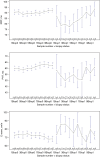Doppler echocardiography for surveillance of acute cardiac allograft rejection: a 28-year single-center experience
- PMID: 38434560
- PMCID: PMC10904291
- DOI: 10.21037/cdt-23-305
Doppler echocardiography for surveillance of acute cardiac allograft rejection: a 28-year single-center experience
Abstract
Background: Endomyocardial biopsies (EMB) are recommended for the detection of acute cardiac rejection (ACR) despite limited sensitivity. We report the long-term post-transplant results of Doppler echocardiography as a noninvasive alternative of routine EMB.
Methods: Two cohorts of heart transplantation (HT) recipients were chronologically defined as follows: the Dual Monitoring Cohort (DMC) from January 1990 to December 1997 included patients who underwent routine EMB and Doppler echocardiography within 24 hours for ACR surveillance; and the "Echo-First Cohort" (EFC), including patients transplanted from January 1998 to December 2018 with Doppler echocardiography as first-line approach for ACR surveillance. Echocardiographic measurements of interest were collected: early diastolic (E) wave peak velocity; pressure half time (PHT) and isovolumetric relaxation time (IVRT). Post-transplant outcomes were reviewed and the Kaplan-Meier approach was used for survival estimates. Inter-operator variability for ultrasound measurements was investigated. Data were collected from medical records from January 2019 to December 2020.
Results: A total of 228 patients were included, 99 patients in the DMC and 129 in the EFC. Overall, 5-, 10- and 15-year survival rates were 65.4%, 55.5% and 44.1% respectively, without any significant difference between the two cohorts (log rank test, P=0.71). Echocardiography variables and EMB findings were associated with a mean area under the receiver operating characteristic curve (AUC-ROC) of 0.73 [95% confidence interval (CI): 0.54-0.91], 0.74 (95% CI: 0.54-0.94) and 0.75 (95% CI: 0.57-0.94) respectively for E wave, PHT and IVRT. IVRT and PHT were significantly decreased, and E wave significantly increased, in case of histologically proven ACR. Inter-operator variability was not significant for E wave and IVRT measurements (P=0.13 and 0.30 respectively).
Conclusions: Doppler echocardiography as a first-line method for surveillance of ACR did not impair long-term results after HT. These findings suggest that this non-invasive approach might be a reasonable alternative to systematic EMB, limiting risk and improving the quality of life.
Keywords: Heart transplantation (HT); acute rejection; echocardiography; endomyocardial biopsy (EMB); long-term outcomes.
2024 Cardiovascular Diagnosis and Therapy. All rights reserved.
Conflict of interest statement
Conflicts of Interest: All authors have completed the ICMJE uniform disclosure form (Available at https://cdt.amegroups.com/article/view/10.21037/cdt-23-305/coif). The authors have no conflicts of interest to declare.
Figures




References
-
- Khush KK, Cherikh WS, Chambers DC, et al. The International Thoracic Organ Transplant Registry of the International Society for Heart and Lung Transplantation: Thirty-fifth Adult Heart Transplantation Report-2018; Focus Theme: Multiorgan Transplantation. J Heart Lung Transplant 2018;37:1155-68. 10.1016/j.healun.2018.07.022 - DOI - PubMed
-
- Godown J, McKane M, Mettler BA, et al. Increased Frequency of Surveillance Biopsy Does Not Improve Pediatric Heart Transplant Outcomes: Time for a Change in Practice? J Heart Lung Transplant 2016;35:S73. 10.1016/j.healun.2016.01.199 - DOI
LinkOut - more resources
Full Text Sources
